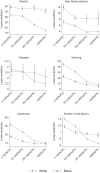Racial and Socioeconomic Disparities in Preconception Health Risk Factors and Access to Care
- PMID: 38563909
- PMCID: PMC11811764
- DOI: 10.1089/jwh.2023.0560
Racial and Socioeconomic Disparities in Preconception Health Risk Factors and Access to Care
Abstract
Background: Black birthing people have significantly higher risks of maternal mortality and morbidity compared with White people. Preconception chronic conditions increase the risk of adverse pregnancy outcomes, yet little is known about disparities in preconception health. This study applies an intersectional framework to examine the simultaneous contributions of racial marginalization and economic deprivation in determining disparities in preconception risk factors and access to care. Methods: Using data from the Pregnancy Risk Assessment Monitoring System, 2016-2020 (N = 123,697), we evaluated disparities by race and income in self-reported preconception hypertension, diabetes, obesity, depression, and smoking, as well as preconception insurance coverage and utilization of health care. We estimated linear regression models and calculated predicted probabilities. Results: Black respondents experienced higher probabilities of preconception obesity and high blood pressure at every income level compared with White respondents. Higher income did not attenuate the probability of obesity for Black respondents (linear trend p = 0.21), as it did for White respondents (p < 0.001). Conversely, while White respondents with low income were at higher risk of preconception depression and smoking than their Black counterparts, higher income was strongly associated with reduced risk, with significantly steeper reductions for White compared with Black respondents (difference in trends p < 0.001 for both risk factors). White respondents had higher probabilities of utilizing preconception care across all income levels, despite similar probabilities of insurance coverage. Conclusions: Higher income does not protect against the risk of preconception obesity and other preconception risk factors for Black birthing people as it does for White birthing people. Results point to the need to consider multiple forms of intersecting structural factors in policy and intervention research to improve preconception and maternal health.
Keywords: PRAMS; chronic disease; health equity; maternal health; preconception health; social determinants of health; structural determinants of health.
Figures


Similar articles
-
Racial and ethnic disparities in fecundability: a North American preconception cohort study.Hum Reprod. 2025 Jun 1;40(6):1183-1194. doi: 10.1093/humrep/deaf067. Hum Reprod. 2025. PMID: 40246287
-
Racial/ethnic disparities in costs, length of stay, and severity of severe maternal morbidity.Am J Obstet Gynecol MFM. 2023 May;5(5):100917. doi: 10.1016/j.ajogmf.2023.100917. Epub 2023 Mar 5. Am J Obstet Gynecol MFM. 2023. PMID: 36882126 Free PMC article.
-
Hospital-level variation in racial disparities in low-risk nulliparous cesarean delivery rates.Am J Obstet Gynecol MFM. 2023 Dec;5(12):101145. doi: 10.1016/j.ajogmf.2023.101145. Epub 2023 Aug 28. Am J Obstet Gynecol MFM. 2023. PMID: 37648109 Free PMC article.
-
Multifaceted behavioral interventions to improve topical glaucoma therapy adherence in adults.Cochrane Database Syst Rev. 2025 Jun 11;6(6):CD015788. doi: 10.1002/14651858.CD015788.pub2. Cochrane Database Syst Rev. 2025. PMID: 40497459 Review.
-
The Black Book of Psychotropic Dosing and Monitoring.Psychopharmacol Bull. 2024 Jul 8;54(3):8-59. Psychopharmacol Bull. 2024. PMID: 38993656 Free PMC article. Review.
Cited by
-
Racial and ethnic disparities in access to community-based perinatal mental health programs: results from a cross-sectional survey.BMC Public Health. 2024 Apr 20;24(1):1094. doi: 10.1186/s12889-024-18517-7. BMC Public Health. 2024. PMID: 38643069 Free PMC article.
-
Home Visits and the Use of Routine and Emergency Postpartum Care Among Low-Income People: A Secondary Analysis of a Randomized Clinical Trial.JAMA Netw Open. 2024 Dec 2;7(12):e2451605. doi: 10.1001/jamanetworkopen.2024.51605. JAMA Netw Open. 2024. PMID: 39714843 Free PMC article. Clinical Trial.
References
MeSH terms
LinkOut - more resources
Full Text Sources
Medical

